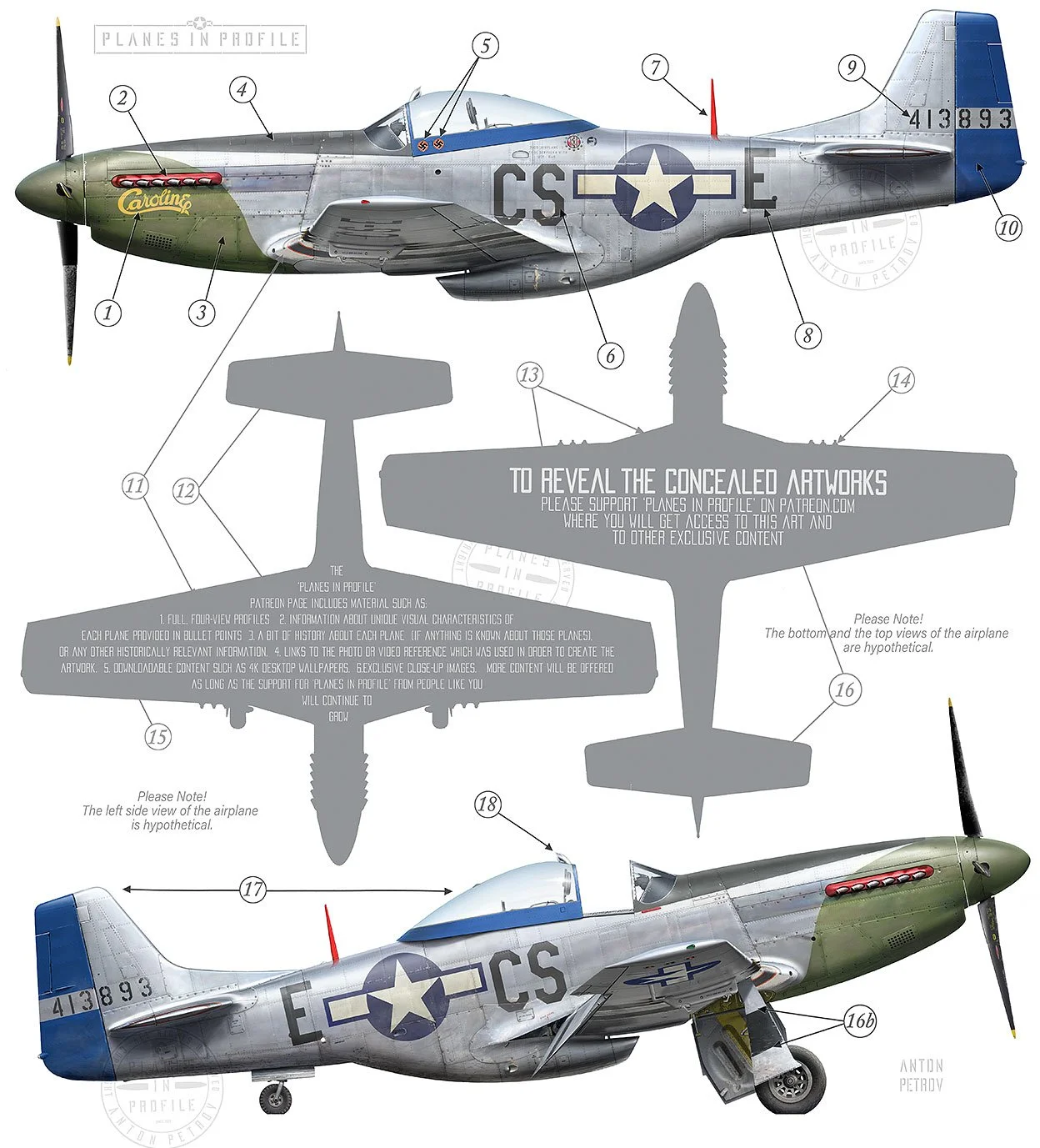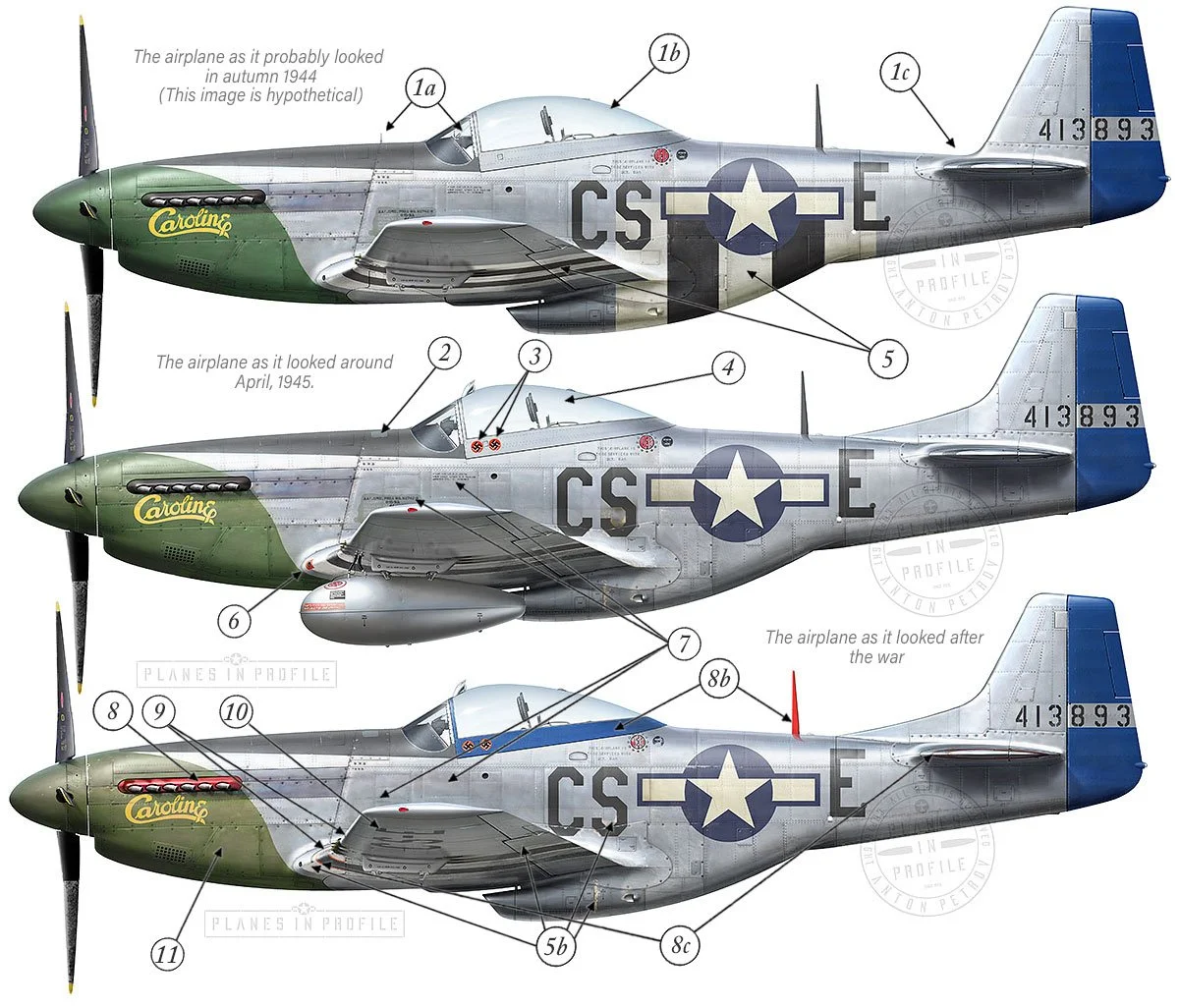Smith’s “Caroline”
North American, P-51D-5-NA (Mustang), Serial number 44-13893
370th Fighter Squadron, 359th Fighter Group, 8th Air Force, East Wretham, Norfolk (England), 1944-1945
Flown by Capt.Thomas Peter ‘Teepee’ Smith.
44-13893 as it might have looked in autumn 1944. This image is hypothetical.
P-51D with a serial number 44-13893 is popular airplane, partly because it’s been relatively well photographed while being stationed in East Wretham, England. Colour photos of this machine can be found on the website of the American Air Museum in Britain. This airplane is one of 359th FG’s longest serving P-51Ds, having served with the group from 1944 until after the war. It was assigned to Lt. T.P. ‘Teepee’ Smith who had recently rejoined the 359th FG following a 5 months journey back to England through enemy occupied territory after baling out of his fuel-starved P-47 behind enemy lines in Netherlands on the 11th of April, 1944. Smith christened his new fighter ‘Caroline’ and this became the plane in which ‘Teepee’ reached his highest achievement of the war when he scored two air victories (and two probables) in this machine, all during the same air battle on November 21st, 1944.
That day the 370th FG was once again tasked with escorting B-17s on a bombing run of synthetic oil targets at Merseburg in Germany. As the bombers reached their target just before 1200 hrs, the 370th spotted a large group of enemy fighters consisting of about 50 FW-190s flying below them. The P-51s dove down onto the enemy. Lt. T. P. Smith pressed the trigger and Caroline’s bullets tore into a FW 190 ripping large pieces off of it and causing the enemy plane to snap down to the right, Caroline’s first victim. As it was going down a second FW-190 slid in front of Caroline from the right. Smith fired a four-second burst blasting off sections of the enemy fighter which flew back past his P-51. Caroline’s second kill. Banking to the right T.P. opened fire at another enemy fighter from about 200 yards hitting it hard in the left wing root and after levelling out he shot at another FW-190 from behind, striking it in the left wing root also and sending it down. These last two were awarded to Lt.T.P. Smith as ‘probable’ kills, the first two were ‘destroyed’.
Nov 21. 2 x FW -190, presumably west of Merseburg (Germany)
2 x FW-190 (probable), presumably west of Merseburg (Germany)
The book ‘359th Fighter Group’ by Jack H. Smith includes T.P.’s own , humorous recollection of this battle;
Ray Wetmore was flying close escort down below, and he knew something was going on because he started yelling his fool head off, “Send down a live one, send down a live one!” He was down below calling, “Where are they?” I said “They’re up here. They’re coming down, they’re coming down”. He said, “all that’s coming down are burning airplanes and parachutes. To hell with that, send me a live one”!’ [1]
The image above shows ‘Caroline’ as it looked around April, 1945. Note the two victory markings which appeared on the canopy frame after the 21st of November, 1944.
44-13893, as it looked just after the war in 1945.
Noteworthy Visual Characteristics
1) The name Caroline was the nickname given to T.P. Smith’s airplane.
2) Note the exhaust shroud had been painted red after April 1945.
3) The green nose marking of the airplanes of the 359th Fighter Group. In the post war photos, the free of Caroline’s nose appears to be quite yellowed and faded compared to the more freshly painted planes in the background.
4) The top of the nose was painted with a non glare paint, possibly black or olive green, as can be seen I the photo linked above.
5) The two images of the swastika (with a white shadow) in a red circle are the victory markings representing T.P.’s two confirmed aerial kills (both achieved on the 21st of November, 1944). Great close-up photo of these can be found HERE.
6) “CS” was the identification code of the 370’s Fighter Squadron.
7) The antenna was repainted red at some stage after April 1945.
8) “E” was the identification code of T.P. Smith’s plane.
9) 413893 indicates the serial number of the airplane (44-13893).
10) The blue rudder was an identification marking of the 370th Fighter Squadron.
11) On Patreon.
12) On Patreon.
13) On Patreon.
14) On Patreon.
15) On Patreon.
16) On Patreon.
17) Note the absence of the antenna wire.
18) Note the mirror on the canopy hood. This was the oblong mirror type which was housed in a clear ‘blister’. It can be clearly visible in this photo of T.P. & Caroline
EVOLUTION OF EXTERNAL APPEARANCE
1) 44-13893 was a P-51D-5NA. This implies that originally the plane was probably equipped with a N-9 gunsight (marked by ‘1a’), it might have originally come with an early -2 type Inglewood canopy (marked by ‘1b’), and had no fin fillet in front of the fin/tail (marked by ‘1c’).
2) The ‘Hydraulic Fuel Tank’ hatch appears lighter than the rest of the nose in the photos. It might have been replaced with an unpainted one at some stage.
3) The victory markings appeared after November 21, 1944.
4) The canopy in the photo reference appears to be a later style Inglewood canopy, with a mirror attached.
5) It’s likely that in Autumn of 1944 the plane had full ‘Invasion stripes’ painted on it. These were replaced with a single stripe later on, but some of the white seems to still be visible in the photos, especially in the areas indicated by ‘5b’.
6) Note the red rectangle around the gun camera in some photos. It doesn’t appear in the later photos.
7) The data stencil looks like it was applied over a repainted (darker background) spot and the crew names are visible just below the canopy. These appear to have been completely erased in the later photos.
8) The plane’s livery was embellished with some colour details such as a red exhaust shroud, a blue canopy frame and a red antenna mast (marked by ‘8b’), and a thin red line on either side of the identification stripes (marked by ‘8c’)
9) The ‘wing lines’ were added to the tops of the wings after the war or just before its end.
10) The letter codes were added to the bottom of the left wing to aid ground crews with identification of the individual airplanes while they are in the air.
11) The green nose looks quite ‘yellowed’ and faded in the photos of Caroline after the war.
FOOTNOTES
[1] Based on the information from the book ‘359th Fighter Group’, by Jack H. Smith, published by Osprey Publishing in 2002, pages 71 and 72, PDF e-book ISBN:978 1 78200 571 1
SUMMARY OF LINKS TO THE REFERENCE IMAGES AND VIDEOS
Photos of the Caroline, (presumably) from around April, 1945:
https://www.americanairmuseum.com/archive/media/media-388533jpg
https://www.americanairmuseum.com/archive/media/media-388562jpg
https://www.americanairmuseum.com/archive/media/media-388590jpg
https://www.americanairmuseum.com/archive/media/media-388570jpg
https://www.americanairmuseum.com/archive/media/media-388557jpg
https://www.americanairmuseum.com/archive/media/media-22173jpeg
Photos of Caroline (presumably) after the war:
https://www.americanairmuseum.com/archive/media/media-388584jpg
https://www.americanairmuseum.com/archive/media/media-388591jpg
https://www.americanairmuseum.com/archive/media/media-388526jpg
All the work presented on this page is subject to updates and revisions in the light of new information which might present itself. If you have any new information relevant to this page or disagree with anything that's presented here, then please contact me through the Planes in Profile Facebook page to help make the content of this page more accurate. Thanks:)







